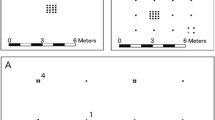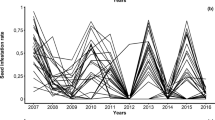Abstract
A multiscale approach has lead to significant advances in the understanding of species population dynamics. The scale-dependent nature of population processes has been particularly clearly illustrated for insect herbivores. However, one of the most well-studied insect herbivores, the galling sawfly Euura lasiolepis, has to date been examined almost exclusively at fine spatial scales. The preference-performance, plant vigour and larval survival hypotheses are well supported by this species. Here, we test these hypotheses at a spatial scale larger than that previously considered, i.e. across a landscape in northern Arizona represented by an altitudinal gradient encompassing a series of drainages. We also develop a qualitative model for understanding the population dynamics of E. lasiolepis based on patterns of survival and mortality found in this study and previous ones. Gall density was highly variable across the altitudinal gradient, not explained by host plant variables, and thus a poor surrogate fot population abundance. These findings for the first time fail to support the plant vigour and preference hierarchy hypotheses for E. lasiolepis. Dispersal limitation most likely explains the lack of support for these hypotheses at this scale. By contrast, sawfly survival, gall abortion, parasitism and larval mortality were well explained by host plant quality variables and altitude. The larval survival hypothesis was well supported and is thus comparatively scale-invariant. A qualitative model developed here highlighted the importance of both willow water status and disturbance in determining host plant quality, as well as an apparent trade off between shoot length and plant moisture status in determining vital rates across the altitudinal gradient. This study thus demonstrated for the first time the scale-dependent nature of mechanisms underlying the population dynamics E. lasiolepis, and identified the interaction between parasitism and altitude as a novel mechanism underlying spatial patterns in the survival and mortality patterns of this species.




Similar content being viewed by others
References
Bevers M, Flather CH (1999) The distribution and abundance of populations limited at multiple spatial scales. J Anim Ecol 68:976–987
Bjorkman C (2000) Interactive effects of host resistance and drought stress on the performance of a gall-making aphid living on Norway spruce. Oecologia 123:223–231
Blackburn TM, Gaston KJ (2002) Scale in macroecology. Global Ecol Biogeog 11:185–189
Borcard D, Legendre P (1994) Environmental control and spatial structure in ecological communities: an example using oribatid mites (Acari, Oribatei). Environ Ecol Stat 1:37–53
Brewer AM, Gaston KJ (2002) The geographical range structure of the holly leaf-miner. I. Population density. J Anim Ecol 71:99–111
Brewer AM, Gaston KJ (2003) The geographical range structure of the holly leaf-miner. II. Demographic rates. J Anim Ecol 72:82–93
Cappuccino N, Price PW (1995) Population dynamics: new approaches and synthesis. Academic, San Diego
Cole RG, Syms C (1999) Using spatial pattern analysis to distinguish causes of mortality: an example from kelp in north-eastern New Zealand. J Ecol 87:963–972
Collett D (1991) Modelling binary data. Chapman & Hall, London
Cornelissen TG, Fernandes GW (2001) Patterns of attack by herbivores on the tropical shrub Bauhinia brevipes (Leguminosae): vigour or chance? Eur J Entomol 98:37–40
Cornell HV, Lawton JH (1992) Species interactions, local and regional process, and limits to the richness of ecological communities: a theoretical perspective. J Anim Ecol 61:1–12
Craig TP, Price PW, Clancy KM, Waring GL, Sacchi CF (1988) Forces preventing coevolution in the three-trophic-level system: willow, a gall-forming herbivore, and parasitoid. In: Spencer KC (ed) Chemical mediation of coevolution. Academic, San Diego, pp 57–80
Craig TP, Itami JK, Price PW (1989) A strong relationship between oviposition preference and larval performance in a shoot-galling sawfly. Ecology 70:1691–1699
Dobson AJ (2002) An introduction to generalized linear models. Chapman & Hall/CRC Texts in Statistical Science, Boca Raton
Faria ML, Fernandes GW (2001) Vigour of a dioecious shrub and attack by a galling herbivore. Ecol Entomol 26:37–45
Fauchald P (1999) Foraging in a hierarchical patch system. Am Nat 153:603–613
Freeman BE, Smith DC (1990) Variation of density-dependence with spatial scale in the leaf-mining fly Liriomyza commelinae (Diptera: Agromyzidae). Ecol Entomol 15:265–274
Godfay HCJ, Hassell MP (1997) Hosts and parasitoids in space. Nature 386:660–661
Hails RS, Crawley MJ (1992) Spatial density dependence in populations of a cynipid gall-former Andricus quercuscalicis. J Anim Ecol 61:567–583
Hanski I (1994) Patch-occupancy dynamics in fragmented landscapes. Trends Ecol Evol 9:131–135
Hanski I (1999) Habitat connectivity, habitat continuity, and metapopulations in dynamic landscapes. Oikos 87:209–219
Hanski I, Woiwod IP (1993) Spatial synchrony in the dynamics of moth and aphid populations. J Anim Ecol 62:656–668
Hanski I, Poyry J, Pakkala T, Kuussaari M (1995) Multiple equilibria in metapopulation dynamics. Nature 377:618–621
Heads PA, Lawton JH (1983) Studies on the natural enemy complex of the holly leaf-miner: the effects of scale on the detection of aggregative responses and the implications for biological control. Oikos 40:267–276
Hjälten J, Price PW (1996) The effect of pruning on willow growth and sawfly population densities. Oikos 77:549–555
Hunter MD (1997) Incorportaing variation in plant chemistry into a spatially-explicit ecology of phytophagous insects. In: Watt AD, Stork NE, Hunter MD (eds) Forests and insects. Chapman & Hall, London, pp 81–96
Hunter MD, Price PW (1992) Playing chutes and ladders: heterogeneity and the relative roles of bottom-up and top-down forces in natural communities. Ecology 73:724–732
Hunter MD, Price PW (1998) Cycles in insect populations: delayed density dependence or exogenous driving variables? Ecol Entomol 23:216–222
Hunter MD, Forkner RE, McNeil JN (2000) Heterogeneity in plant quality and its impact on the population ecology of insect herbivores. In: Hutchings MJ, John EA, Stewart AJA (eds) The ecological consequences of environmental heterogeneity. Blackwell, Oxford, pp 155–179
Inouye BD (1999) Integrating nested spatial scales: implications for the coexistence of competitors on a patchy resource. J Anim Ecol 68:150–162
Larsson S (1989) Stressful times for the plant–insect performance hypothesis. Oikos 56:277–283
Legendre P, Fortin M-J (1989) Spatial patterning and ecological analysis. Vegetation 80:107–138
Legendre L, Legendre P (1998) Numerical ecology. Elsevier, Amsterdam
Levin SA (1992) The problem of pattern and scale in ecology. Ecology 73:1943–1967
Logerwell EA, Hewitt RP, Denmer DA (1998) Scale-dependent spatial variance patterns and correlations of seabirds and prey in southeastern Bering Sea as revealed by spectral analysis. Ecography 21:212–223
McCullagh P, Nelder JA (1989) Generalized linear models. Chapman & Hall, London
McGeoch MA, Gaston KJ (2000) Edge effects on the prevalence and mortality factors of Phytomyza ilicis (Diptera, Agromyzidae) in a suburban woodland. Ecol Lett 3:23–29
McGeoch MA, Gaston KJ (2002) Occupancy frequency distributions: patterns, artefacts and mechanisms. Biol Rev 77:311–331
McGeoch MA, Price PW (2004) Spatial abundance structures in an assemblage of gall-forming sawflies. J Anim Ecol 73:506–516
Merriam CH (1890) Results of a biological survey of the San Francisco Mountain Region and desert of the Little Colorado, Arizona. Government Printing Office, Washington
Norowi HM, Perry JN, Powell W, Rennolls K (2000) The effect of spatial scale on interactions between two weevils and their parasitoid. Ecol Entomol 25:188–196
Palmer MW, White PS (1994) Scale dependence and the space–area relationship. Am Nat 144:717–740
Palmer MA, Allan JD, Butman CA (1996) Dispersal as a regional process affecting the local dynamics of marine and stream benthic invertebrates. Trends Ecol Evol 11:322–326
Preszler RW, Price PW (1988) Host quality and sawfly populations: a new approach to life table analysis. Ecology 69:2012–2020
Price PW (1988) Inversely density-dependent parasitism: the role of plant refuges for hosts. J Anim Ecol 57:89–96
Price PW (1991) The plant vigor hypothesis and herbivore attack. Oikos 62:244–251
Price PW (2003) Macrevolutionary theory on macroecological patterns. Cambridge University Press, Cambridge
Price PW, Clancy KM (1986a) Multiple effects of precipitation on Salix lasiolepis and populations of the stem-galling sawfly, Euura lasiolepis. Ecol Res 1:1–14
Price PW, KM Clancy (1986b) Interactions among three trophic levels: gall size and parasitoid attack. Ecology 67:1593–1600
Price PW, Craig TP (1984) Life history, phenology and survivorship of a stem-galling sawfly, Euura lasiolepis (Hymenoptera: Tenthredinidae), on the arroyo willow, Salix lasiolepis, in northern Arizona. Ann Entomol Soc Am 77:712–719
Price PW, Clancy KM, Roininen H (1993) Comparative population dynamics of the galling sawflies. In: Price PW, Mattson WJ, Baranchikov YN (eds) The ecology and evolution of gall-forming insects. United States Department of Agriculture, Minnesota, pp 1–11
Price PW, Craig TP, Roininen H (1995) Working towards theory on galling sawfly population dynamics. In: Cappuccino N, Price PW (eds) Population dynamics: new approaches and synthesis. Academic, New York, pp 321–338
Price PW, Fernandes GW, Lara ACF, Brawn J, Barrios H, Wright MG, Ribeiro SP, Rothcliff N (1998) Global patterns in local number of insect galling species. J Biogeography 25:581–591
Quinn GP, Keough MJ (2002) Experimental design and data analysis for biologists. Cambridge University Press, Cambridge
Ray C, Hastings A (1996) Density dependence: are we searching at the wrong spatial scale? J Anim Ecol 65:556–566
Ribeiro KT, Codeco CT, Fernandes GW (2003) Local and regional spatial distribution of an eruptive and a latent herbivore insect species. Aust Ecol 28:99–107
Roininen H, Price PW, Julkunen-Titto R, Tahvanainen J, Ikonen A (1999) Oviposition stimulant for a gall-inducing sawfly, Euura lasiolepis, on willow is a phenolic glucoside. J Chem Ecol 25:943–953
Royama T (1992) Analytical population dynamics. Chapman & Hall, London
Southwood TRE, Comins HN (1976) A synoptic population model. J Anim Ecol 45:949–965
Stein SJ, Price PW, Abrahamson WG, Sacchi CF (1992) The effect of fire on stimulating willow regrowth and subsequent attack by grasshoppers and elk. Oikos 65:190–196
Stein SJ, Price PW, Craig TP, Itami JK (1994) Dispersal of a galling sawfly: implications for studies of insect population dynamics. J Anim Ecol 63:666–676
Stoll P, Prati D (2001) Intraspecific aggregation alters competitive interactions in experimental plant communities. Ecology 82:319–327
Sutcliffe OL, Thomas CD, Moss D (1996) Spatial synchrony and asynchrony in butterfly population dynamics. J Anim Ecol 65:85–95
Thomas CD, Kunin WE (1999) The spatial structure of populations. J Anim Ecol 68:647–657
Thomson JD, Weiblen G, Thomson BA, Alfaro S, Legendre P (1996) Untangling multiple factors in spatial distributions: lilies, gophers, and rocks. Ecology 77:1698–1715
Tilman D, Lehman CL, Kareiva P (1997) Population dynamics in spatial habitats. In: Tilman D, Kareiva P (eds) Spatial ecology. Princeton University Press, New Jersey, pp 3–20
Veldtman R, McGeoch MA (2004) Spatially explicit analyses unveil density dependence. Proc R Soc Lond B 271:2439–2444
Walde SJ, Murdoch WW (1988) Spatial density dependence in parasitoids. Annu Rev Entomol 33:441–466
Waring GL, Price PW (1988) Consequences of host plant chemical and physical variability to an associated herbivore. Ecol Res 3:205–216
Wiens JA (1989) Spatial scaling in ecology. Functional Ecol 3:385–397
Williams DW, Liebhold AM (2000) Spatial synchrony of spruce budworm outbreaks in eastern North America. Ecology 81:2753–2766
Williams IS, Heffin Jones T, Hartley SE (2001) The role of resources and natural enemies in determining the distribution of an insect herbivore population. Ecol Entomol 26:204–211
Winder L, Alexander CJ, Holland JM, Woolley C, Perry JN (2001) Modeling the dynamic spatio-temporal response of predators to transient prey patches in the field. Ecol Lett 4:568–576
Acknowledgements
We thank the Fulbright Commission for supporting the visit of M.A.M to the University of Northern Arizona. S.L. Chown is thanked for comments on the manuscript. The South African National Research Foundation contributed to the funding of this research (GUN 2053618). The research reported here complies with the current laws of the countries in which it was conducted.
Author information
Authors and Affiliations
Corresponding author
Additional information
Communicated by Bernhard Stadler
Rights and permissions
About this article
Cite this article
McGeoch, M.A., Price, P.W. Scale-dependent mechanisms in the population dynamics of an insect herbivore. Oecologia 144, 278–288 (2005). https://doi.org/10.1007/s00442-005-0073-9
Received:
Accepted:
Published:
Issue Date:
DOI: https://doi.org/10.1007/s00442-005-0073-9




